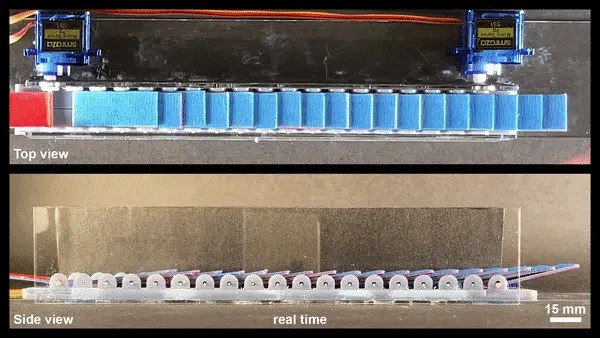
Whether it be the fluid motions of the centipede as it propels itself along, or the intestines ability to usher food through the digestive system, it has long been a goal of scientists to mimic and reproduce the intricate wavelike motions that biological organisms utilize for movement. Researchers thus far have had great difficulty recreating the subtle and efficient series of coordinated muscle contractions, known as peristalsis, that animals use to move themselves.
Attempts have been made in robotics systems to mimic a soliton, one single wave in the series, but resulting products still rely on a complicated and expensive chain of individual actuators.
A recent paper from the Pikul group, led by Assistant Professor in the Department of Mechanical Engineering and Applied Mechanics (MEAM) James Pikul, is exploring a much simpler approach to generating soliton waves: dominoes.
Pikul and team performed a series of experiments that included a conveyor-like creation that can push objects along a curved path ahead of the soliton, and a soliton-powered mantis shrimp robot. It was Yichao Shi, first author of the paper and MEAM Ph.D. candidate, who first realized that because falling dominoes exhibit soliton behavior as they topple in sequence, they could be used towards realizing a wavelike motion in a robotic actuator.
In a recent interview with IEEE Spectrum, Pikul and Shi discussed key ways in which their designs differ from those in nature. With the intention to create a system that is easier to control, the researchers decided to use a single point of actuation at the system’s boundary domino.
“Since our synthetic muscles are less powerful and efficient than animal muscles, we didn’t see coordinated actuation of multiple individual synthetic muscles as an effective way to realize our goals. So, in our system, all the dominoes are linked and constrained by mechanical contact so that they create a soliton with a single signal that is sent to the boundary domino. The advantage of this approach, where only the boundaries have actuators, is that the system is easier to control and build than systems that more precisely mimic biology, and the mechanical constraints make the cascading dominoes easy to apply to different scales. However, the lower degrees of freedom also mean the dominoes have limits in how robust and agile they can be. It is difficult, for example, to push multiple objects through the cascading dominoes at once, or to push liquids. In addition, the dominoes are hard, and although they can be made flexible, the synthetic system is not as compliant as the natural systems.”
Read the full article, “Cascading Domino Actuator Transports Objects With a Soliton Wave,” at IEEE Spectrum.
